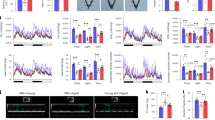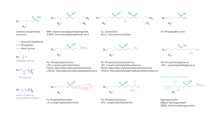Abstract
The biophysical environment of membrane phospholipids affects the structure, function, and stability of membrane-bound proteins1,2. Obesity can disrupt membrane lipids, and, in particular, alter the activity of sarco-endoplasmic reticulum Ca2+-ATPase (SERCA) to affect cellular metabolism3,4,5. Recent evidence suggests that the transport efficiency (Ca2+ uptake and ATP hydrolysis) of skeletal muscle SERCA can be uncoupled to increase energy expenditure and protect mice from diet-induced obesity6,7. In isolated sarcoplasmic reticulum vesicles, membrane phospholipid composition is known to modulate SERCA efficiency8,9,10,11. Here we show that skeletal muscle sarcoplasmic reticulum phospholipids can be altered to decrease SERCA efficiency and increase the whole-body metabolic rate. The absence of skeletal muscle phosphatidylethanolamine methyltransferase (PEMT) promotes an increase in the skeletal muscle and whole-body metabolic rate to protect mice from diet-induced obesity. The elevation in metabolic rate is caused by a decrease in SERCA Ca2+-transport efficiency, whereas mitochondrial uncoupling is unaffected. Our findings support the hypothesis that skeletal muscle energy efficiency can be reduced to promote protection from obesity.
This is a preview of subscription content, access via your institution
Access options
Access Nature and 54 other Nature Portfolio journals
Get Nature+, our best-value online-access subscription
$29.99 / 30 days
cancel any time
Subscribe to this journal
Receive 12 digital issues and online access to articles
$119.00 per year
only $9.92 per issue
Buy this article
- Purchase on Springer Link
- Instant access to full article PDF
Prices may be subject to local taxes which are calculated during checkout




Similar content being viewed by others
Data availability
Data that support the findings of this study are available from the corresponding author upon reasonable request.
References
Laganowsky, A. et al. Membrane proteins bind lipids selectively to modulate their structure and function. Nature 510, 172–175 (2014).
Gupta, K. et al. The role of interfacial lipids in stabilizing membrane protein oligomers. Nature 541, 421–424 (2017).
Fu, S. et al. Aberrant lipid metabolism disrupts calcium homeostasis causing liver endoplasmic reticulum stress in obesity. Nature 473, 528–531 (2011).
Funai, K. et al. Muscle lipogenesis balances insulin sensitivity and strength through calcium signaling. J. Clin. Invest. 123, 1229–1240 (2013).
Funai, K. et al. Skeletal muscle phospholipid metabolism regulates insulin sensitivity and contractile function. Diabetes 65, 1–37 (2016).
Bal, N. C. et al. Sarcolipin is a newly identified regulator of muscle-based thermogenesis in mammals. Nat. Med. 18, 1575–1579 (2012).
Maurya, S. K. et al. Sarcolipin is a key determinant of basal metabolic rate and its overexpression enhances energy expenditure and resistance against diet induced obesity. J. Biol. Chem. 290, 10840–10849 (2015).
Caffrey, M. & Feigenson, G. W. Fluorescence quenching in model membranes. 3. Relationship between calcium adenosinetriphosphatase enzyme activity and the affinity of the protein for phosphatidylcholines with different acyl chain characteristics. Biochemistry 20, 1949–1961 (1981).
Navarro, J., Toivio-Kinnucan, M. & Racker, E. Effect of lipid composition on the calcium/adenosine 5′-triphosphate coupling ratio of the Ca2+-ATPase of sarcoplasmic reticulum. Biochemistry 23, 130–135 (1984).
Lervik, A., Bresme, F., Kjelstrup, S. & Rubi, J. M. On the thermodynamic efficiency of Ca2+-ATPase molecular machines. Biophys. J. 103, 1218–1226 (2012).
Fajardo, V. A. et al. Dietary docosahexaenoic acid supplementation reduces SERCA Ca2+ transport efficiency in rat skeletal muscle. Chem. Phys. Lipids 187, 56–61 (2015).
Sharma, N. K., Langberg, K. A., Mondal, A. K. & Das, S. K. Phospholipid biosynthesis genes and susceptibility to obesity: analysis of expression and polymorphisms. PLoS ONE 8, e65303 (2013).
Jacobs, R. L. et al. Impaired de novo choline synthesis explains why phosphatidylethanolamine N-methyltransferase-deficient mice are protected from diet-induced obesity. J. Biol. Chem. 285, 22403–22413 (2010).
Tasseva, G. et al. Lack of phosphatidylethanolamine N-methyltransferase in mice does not promote fatty acid oxidation in skeletal muscle. Biochim. Biophys. Acta 1861, 119–129 (2016).
Gao, X. et al. Insufficient glucose supply is linked to hypothermia upon cold exposure in mice lacking phosphatidylethanolamine N-methyltransferase. J. Lipid Res. 56, 1701–1710 (2015).
Ferrara, P. J., Verkerke, A. R. P., Brault, J. J. & Funai, K. Hypothermia decreases O2 cost for ex vivo contraction in mouse skeletal muscle. Med. Sci. Sports Exerc. 50, 2015–2023 (2018).
Li, B. et al. Skeletal muscle respiratory uncoupling prevents diet-induced obesity and insulin resistance in mice. Nat. Med. 6, 1115–1120 (2000).
Fisher-Wellman, K. H. et al. Pyruvate dehydrogenase complex and nicotinamide nucleotide transhydrogenase constitute an energy-consuming redox circuit. Biochem. J. 467, 271–280 (2015).
Cui, Z., Vance, J. E., Chen, M. H., Voelker, D. R. & Vance, D. E. Cloning and expression of a novel phosphatidylethanolamine N-methyltransferase. A specific biochemical and cytological marker for a unique membrane fraction in rat liver. J. Biol. Chem. 268, 16655–16663 (1993).
Smith, I. C., Bombardier, E., Vigna, C. & Tupling, A. R. ATP consumption by sarcoplasmic reticulum Ca2+ pumps accounts for 40–50% of resting metabolic rate in mouse fast and slow twitch skeletal muscle. PLoS ONE 8, 1–11 (2013).
Ikeda, K. et al. UCP1-independent signaling involving SERCA2b-mediated calcium cycling regulates beige fat thermogenesis and systemic glucose homeostasis. Nat. Med. 23, 1454–1465 (2017).
Paran, C. W. et al. Reduced efficiency of sarcolipin-dependent respiration in myocytes from humans with severe obesity. Obesity (Silver Spring) 23, 1440–1449 (2015).
Durham, W. J. et al. RyR1 S-Nitrosylation underlies environmental heat stroke and sudden death in Y522S RyR1 knockin mice. Cell 133, 53–65 (2008).
Shields, D. J., Agellon, L. B. & Vance, D. E. Structure, expression profile and alternative processing of the human phosphatidylethanolamine N-methyltransferase (PEMT) gene. Biochim. Biophys. Acta 1532, 105–114 (2001).
Samborski, R. W., Ridgway, N. D. & Vance, D. E. Metabolism of molecular species of phosphatidylethanolamine and phosphatidylcholine in rat hepatocytes during prolonged inhibition of phosphatidylethanolamine N-methyltransferase. J. Lipid Res. 34, 125–137 (1993).
Kajimura, S., Spiegelman, B. M. & Seale, P. Brown and beige fat: physiological roles beyond heat generation. Cell Metab. 22, 546–559 (2015).
Zurlo, F., Larson, K., Bogardus, C. & Ravussin, E. Skeletal muscle metabolism is a major determinant of resting energy expenditure. J. Clin. Invest. 86, 1423–1427 (1990).
Lee, S. et al. Skeletal muscle phosphatidylcholine and phosphatidylethanolamine respond to exercise and influence insulin sensitivity in men. Sci. Rep. 8, 6531 (2018).
Newsom, S. A. et al. Skeletal muscle phosphatidylcholine and phosphatidylethanolamine are related to insulin sensitivity and respond to acute exercise in humans. J. Appl. Physiol. 120, 1355–1363 (2016).
Ravussin, Y., Leibel, R. L. & Ferrante, A. W. Jr. A missing link in body weight homeostasis: the catabolic signal of the overfed state. Cell Metab. 20, 565–572 (2014).
Walkey, C. J., Donohue, L. R., Bronson, R., Agellon, L. B. & Vance, D. E. Disruption of the murine gene encoding phosphatidylethanolamine N-methyltransferase. Proc. Natl Acad. Sci. USA 94, 12880–12885 (1997).
McCarthy, J. J., Srikuea, R., Kirby, T. J., Peterson, C. A. & Esser, K. A. Inducible Cre transgenic mouse strain for skeletal muscle-specific gene targeting. Skelet. Muscle 2, 8 (2012).
Postic, C. et al. Dual roles for glucokinase in glucose homeostasis as determined by liver and pancreatic β cell-specific gene knock-outs using Cre recombinase. J. Biol. Chem. 274, 305–315 (1999).
Huang, H. et al. Rho-kinase regulates energy balance by targeting hypothalamic leptin receptor signaling. Nat. Neurosci. 15, 1391–1398 (2012).
Laing, B. T. et al. Voluntary exercise improves hypothalamic and metabolic function in obese mice. J. Endocrinol. 229, 109–122 (2016).
Lark, D. S. et al. Direct real-time quantification of mitochondrial oxidative phosphorylation efficiency in permeabilized skeletal muscle myofibers. Am. J. Physiol. 311, C239–C245 (2016).
Johnson, J. M. et al. Targeted overexpression of catalase to mitochondria does not prevent cardioskeletal myopathy in barth syndrome. J. Mol. Cell. Cardiol. 121, 94–102 (2018).
Gilliam, L. A. A. et al. Free radical biology and medicine the anticancer agent doxorubicin disrupts mitochondrial energy metabolism and redox balance in skeletal muscle. Free Radic. Biol. Med. 65, 988–996 (2013).
Ferdaoussi, M. et al. Isocitrate-to-SENP1 signaling amplifies insulin secretion and rescues dysfunctional β cells. J. Clin. Invest. 125, 3847–3860 (2015).
Gan, Z. et al. The nuclear receptor PPARβ/δ programs muscle glucose metabolism in cooperation with AMPK and MEF2. Genes Dev. 25, 2619–2630 (2011).
Zechner, C. et al. Total skeletal muscle PGC-1 deficiency uncouples mitochondrial derangements from fiber type determination and insulin sensitivity. Cell Metab. 12, 633–642 (2010).
Schuh, R. A., Jackson, K. C., Khairallah, R. J., Ward, C. W. & Spangenburg, E. E. Measuring mitochondrial respiration in intact single muscle fibers. Am. J. Physiol. 302, R712–R719 (2012).
Matyash, V. et al. Lipid extraction by methyl-tert-butyl ether for high-throughput lipidomics. J. Lipid Res. 49, 1137–1146 (2008).
Simonides, W. S. & van Hardeveld, C. An assay for sarcoplasmic reticulum Ca2+-ATPase activity in muscle homogenates. Anal. Biochem. 191, 321–331 (1990).
Brault, J. J., Pizzimenti, N. M., Dentel, J. N. & Wiseman, R. W. Selective inhibition of ATPase activity during contraction alters the activation of p38 MAP kinase isoforms in skeletal muscle. J. Cell. Biochem. 114, 1445–1455 (2013).
Aracena-Parks, P. et al. Identification of cysteines involved in S-nitrosylation, S-glutathionylation, and oxidation to disulfides in ryanodine receptor type 1. J. Biol. Chem. 281, 40354–40368 (2006).
Acknowledgements
This research is supported by NIH DK107397, DK109888 (to K.F.), DK110656 (to P.D.N.), DK112826, DK108833 (to W.L.H.), DK115824, DK116450 (to S.A.S.), DK103930 (to C.J.V.), AR066660 (to E.E.S.), AR070200 (to J.J.B.), HL129362 (to T.E.R.), and DK091317 (to T.S.T.), P&F funding from P30 DK020579 at Washington University in St. Louis (to K.F.), American Heart Association 18PRE33960491 (to A.R.P.V.) and 19PRE34380991 (to J.M.J.), Larry H. & Gail Miller Family Foundation (to P.J.F. and C.J.V.), and Uehara Memorial Foundation (to H.E.). University of Utah Metabolomics Core Facility is supported by S10 OD016232, S10 OD021505, and U54 DK110858.
Author information
Authors and Affiliations
Contributions
A.R.P.V. and K.F. designed the study and wrote the manuscript. A.R.P.V. performed all metabolic phenotyping and biochemical assays. A.R.P.V., P.J.F., and E.E.S. performed muscle oxygen consumption assays. C.-T.L., J.M.J., T.E.R., and P.D.N. performed mitochondrial phenotyping. H.E. and P.S. assisted in muscle histology and functional measurements. C.J.V. assisted in experiments with adipose tissues. T.S.T., S.A.S., and W.L.H. assisted in AAV experiments. J.A.M. and J.E.C. performed mass spectrometry analyses. A.R.P.V. and J.J.B performed ultra-performance liquid chromatography. B.T.L and H.H. performed analyses on hypothalamus. A.R.P.V., C.W.P., E.J.W., D.E.V., and K.F. designed and generated the mouse models. T.E.R., H.H., E.E.S., J.J.B., S.A.S., W.L.H., J.E.C., D.E.V., and P.D.N. edited the manuscript.
Corresponding author
Ethics declarations
Competing interests
The authors declare no competing financial interests.
Additional information
Peer review information Primary Handling Editor: Elena Bellafante.
Publisher’s note Springer Nature remains neutral with regard to jurisdictional claims in published maps and institutional affiliations.
Supplementary information
Supplementary Information
Supplementary Figures 1–8
Rights and permissions
About this article
Cite this article
Verkerke, A.R.P., Ferrara, P.J., Lin, CT. et al. Phospholipid methylation regulates muscle metabolic rate through Ca2+ transport efficiency. Nat Metab 1, 876–885 (2019). https://doi.org/10.1038/s42255-019-0111-2
Received:
Accepted:
Published:
Issue Date:
DOI: https://doi.org/10.1038/s42255-019-0111-2
This article is cited by
-
Skeletal muscle inefficiency protects against obesity
Nature Metabolism (2019)



